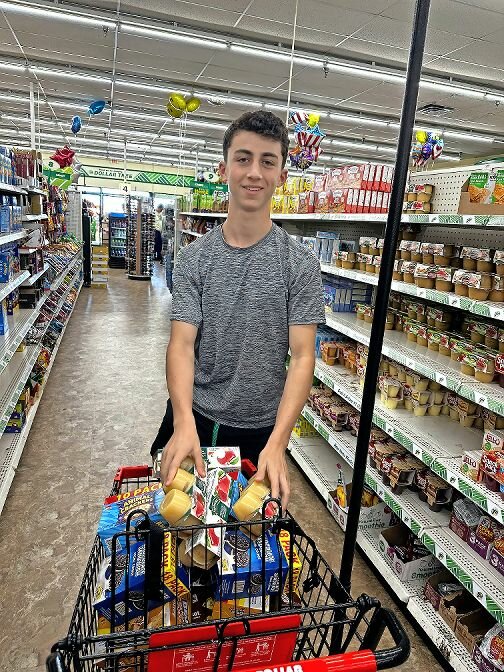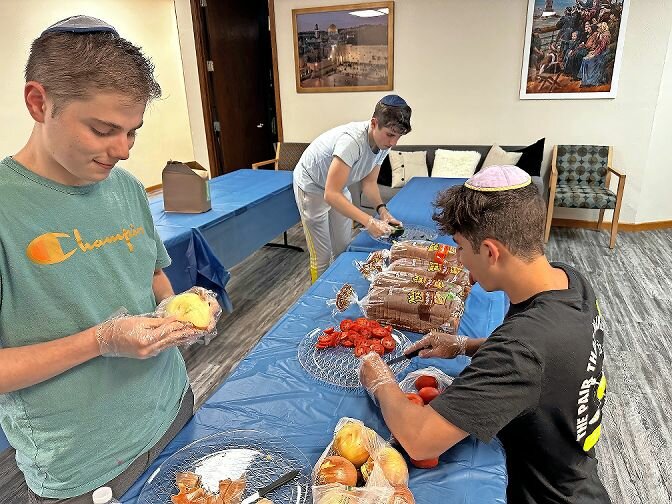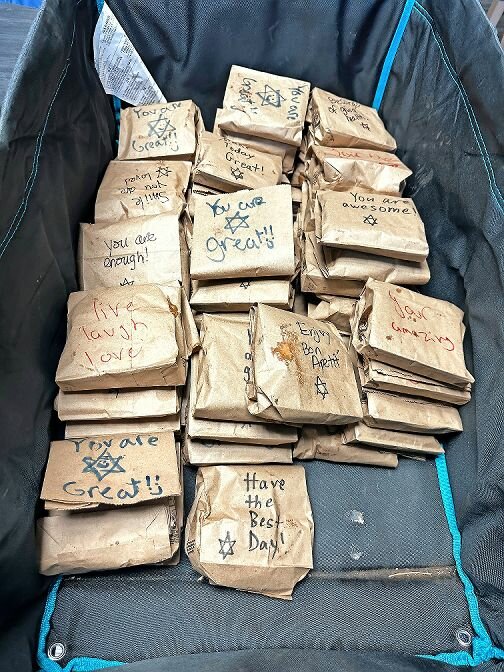SAR students help migrants on the southern U.S. border
Five seniors provided much-needed compassion while at Phoenix shelters
“Where am I?”
That is what an asylum seeker asked Adam Burian of New Rochelle, one of five incoming seniors at Salanter Akiba Riverdale High School who took time out of their summer break to volunteer at a temporary shelter for those who are seeking asylum in Phoenix to assimilate to their new country.
Burian explained they were at Mount of Olives Evangelical Lutheran Church. He was told that while the migrants were not told what was next for them they had to relocate to their destination within three days.
The migrant meant, “Where am I in this world.” Which took Burian aback.
The journey to the United States is long and can be dangerous. In 2022, nine people died while swimming the Rio Grande River to reach the “American Dream.” Also, some spent weeks crossing jungles in Central America and traveling through different countries to meet at the border with Mexico.
Some had chosen New York but did not know how much farther they needed to travel.
Burian, Yishama Orlow of White Plains, Harrison Brooks of Riverdale, Matthew Ruben and Jordana Rudolph from Teaneck, New Jersey, all had impactful experiences and moments of reflection while helping feed and give shelter to those seeking refuge after seeing about 200 people daily.
While all the students are from SAR, the Jewish school did not choose these students to go.
For Orlow, it was a quick email and a phone conversation. Right away, he booked his ticket.
“There’s a group that would come in (Mount of Olives Lutheran Church) every other month and they try to have as many people as possible to volunteer with them,” Brooks said.
So, how did students from Riverdale get an opportunity such as this?
Rabbi Dr. Shmuly Yanklowitz, founder and president of Uri L’Zedek, an Orthodox social justice organization, came to speak at SAR last spring, discussing the immigration situation at the border. Also, he mentioned the Jewish connection and why they are influenced by their faith to help others.
“We’ve been blown away by the commitment of the SAR students who have visited us near the border. These students have big questions, rigorous discipline and a real passion for serving,” the rabbi said.
“We’re so inspired to see how bright our Modern Orthodox future will be with role models like these emerging in leadership who understand that our particularistic commitments are intertwined with our universalistic commitments. And that we must build Am Yisrael and also work for the betterment of society and stand up for the most vulnerable.”
After quoting different verses from the Torah — the Old Testament — they were inspired to help people and help strangers.
However, when asked if helping out made them closer to their religion, they had mixed feelings. Brooks said the fact different religions were together helping, volunteering and partnering with the church was inspiring.
But Orlow counters that claim.
“Every shelter is a church,” he said. “How many synagogues are opening the doors for immigrants to come, to feed and clothe them? We have spaces, we have synagogues.”
When Orlow spoke with Eddie Chavez Calderon, campaign director for Uri L’Zedek, he explained that it is all bureaucracy. Approval needs to come from the board and can take some time that people don’t have.
Yet, Burian says there are not as many synagogues compared to churches.
“You have to balance it between there’s only a few synagogues in the United States versus a lot more churches,” he said. “However, I think it is going to make you feel closer (volunteering) by doing it in real life versus charity.”
According to the Federal Emergency Management Agency — FEMA — there are approximately 3,400 synagogues in the United States compared to 380,000 churches, the National Congregational Study Survey estimated.
Charity giving is one of the Jewish community’s most common forms of helping.
All the students saw people from all around the world: Central America, Western Africa, South America and even Eastern Africa. All communicated in different languages and shared different cultures for the short time they were there.
Brooks and Orlow were even communicating with the migrants in French and Spanish.
For Burian, any language was irrelevant on day one for the newcomers. They felt hopeless, he said. Some were begging for food or clothing.
“The people that came day one were feeling different emotions than those who came on day three,” he said.
Before summer hit, the federal government encouraged asylum seekers to apply through an online process in an effort to prevent illegal crossings.
Title 42 — a pandemic era ban used by President Donald Trump to halt the migration of immigrants and asylum seekers from crossing the Mexican border — was partially discontinued under President Joe Biden earlier this year. He wound up putting in place some restrictions to slow down the pace of migrants entering the United States.
In June, the first month after lifting Title 42, U.S. border patrol recorded almost one million encounters between ports of entry along the Southwest border — a 42 percent decrease from May, making it the lowest monthly Southwest border migration since February 2021, according to the U.S. Customs and Border Protection agency.
Burian came with an open mind and “no expectations.” He didn’t know what to expect since the ending of Title 42. But he really wished he visited the border. Unfortunately, there was violence and they could not visit, he said.
“I got to see stuff that I would have never expected in my lifetime to ever see, I thought it was a special opportunity to go all the way out to Phoenix and experience this,” he said. “It was an unplanned visit, and it basically came out of nowhere.”
When Orlow first arrived, he met with Calderon to buy roughly $80 of snacks and hygiene products and packed 40 bags for the asylum seekers.
Orlow and Brooks told The Riverdale Press that Calderon is a former migrant whose parents packed up their bags after witnessing a brutal cartel murder in southern Mexico. Almost immediately after his mother crossed the border, a woman driving in her car spotted them and paid for their meal.
Since then, Calderon also wanted to help others receive their first meal.
“They needed the help wherever they could get it and whatever is most pressing need at the moment and in my experience,” Brooks said. “Everyone I was with was down to do what was needed to help the operation run as smoothly as possible.” They also helped make sandwiches, prepare food for the day to come, and sort clothing from different donations. Also, they set up the dining room with tables and chairs and swept everything up.
“My dad asked me, ‘Do you feel like you did something, or was this just the experience to Phoenix?’ I think it was twofold,” Burian said. “I think we did help a lot. And I think on the other side, I think by virtue of being there I had a real experience and really got to see it.”
As their journey was short, these volunteers said they would find a way back to Arizona and help them again.











